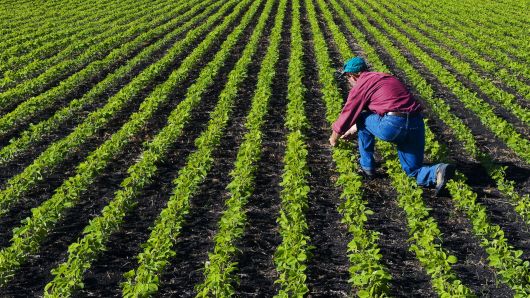
China unleashed a retaliatory tariff exactly one week ago on U.S. soybeans, but Canadian growers haven’t been able to escape the fallout.
Soybean futures are down nearly 20 percent since early April when Beijing first disclosed plans for the 25 percent duty. Canada’s soy prices are closely tied the U.S. futures market so farmers from Quebec and Ontario to the Prairie provinces have taken a hit in terms of pricing along with American growers.
“The China-U.S. dispute is a negative for Canada in many, many ways because we are being caught in the crossfire,” said Benjamin Tal, the deputy chief economist of CIBC World Markets in Toronto.
Soybean futures for August delivery plunged as much as 2 percent to near decade lows Friday a day after the U.S. Department of Agriculture forecast record stockpiles of beans in the 2018-19 crop year due to lower anticipated exports as a result of the trade war with China. It also hasn’t helped that talks have not produced any thaw in the trade war with China.
“We’re back on the trade fears once again here today,” said Ted Seifried, vice president and chief market strategist with Zaner Ag Hedge in Chicago. “It doesn’t seem like there’s any end in sight and things continue to escalate. And that’s why soybeans have continued to be under pressure.”
A net negative
On the one hand, Canadian soybean farmers could see increased market share selling to China, but experts say the price aspect is much more significant. So the net result is a negative for producers.
“If the U.S. price falls, our price basically is the same – it goes down with them,” said Ken Ball, a senior commodities future adviser at PI Financial Corp. in Winnipeg. “North America has really become one large agricultural market with virtually no border, so all of the soybeans produced by a grower in southern Manitoba or Ontario are priced basically directly off the U.S. futures market.”
Ron Davidson, the executive director of Soy Canada, was quoted last week by the Canadian Press news agency as indicating that prices, since the tariff was announced by Beijing, have essentially given back any gains local growers may have seen from exports to China.
“Certainly the negative side far outweighs the opportunities for some potential small amount of gain on the positive side,” Davidson was quoted as saying.
A different scenario could unfold later this year for Canadian producers, however, when China’s soybean shipments from Brazil begin to decline.
Possible relief from China
Brazil remains the largest seller of soybeans to China, but its exports to China tend to be exhausted in the fall months or December. Canadian soy producers, meanwhile, traditionally begin harvesting their crop in September and have one obvious advantage over Americans: no 25 percent retaliatory import tax.
“I’m sure Canada will export as much as they can to China,” said John Baize, president of John C. Baize and Associates, a consultant for the U.S. Soybean Export Council. “They can do it very easily and even ship all their soybeans to China and then buy U.S. soybeans to supply Canada.”
As part of its escalating trade tussle with Washington, the Chinese government has been encouraging importers to look for non-U.S. agricultural and food products. Beijing also has sought to assure domestic users that there are sufficient state reserves of soybeans but the actual size of stockpiles is unknown.
China buys about two-thirds of the world’s soybean exports, using most of it for soy protein to feed roughly 700 million pigs in the country or to make cooking oil. The soy also is used for feeding poultry and to support the country’s fish-farming sector.
According to Reuters, Chinese buyers have so far this year accounted for less than 20 percent of all the early purchases of the U.S. fall soybeans, or well below the 10-year average of 60 percent. Instead, the current “bargain” prices appear to have sparked interest from other buyers, including Mexico.
The Canola alternative
China has forecast its total soybean imports will be down for the next crop year due to the new tariffs. Another factor is the government is encouraging the use of alternative animal feeds.
Experts say Canada’s canola farmers stand to benefit since the product is used as an alternative livestock feed to soy, although it contains less protein. Canola generates roughly one quarter of all farm cash receipts in Canada.
China is already one of the large buyers of Canadian canola, particularly the raw seed, according to the Canola Council of Canada. And Canola prices have been holding up better than soy prices and some of that could be on the expectation of more China buying.
Still, Baize said shipments of Canadian soy to China should be able to get a premium price over the U.S. beans since there’s no tariff involved but probably won’t fetch as much as Brazilian beans since the protein content is lower. As of this week, Brazilian soybeans were getting premium of about $1.50 a bushel compared with U.S. beans.
“As things get tighter in China on soybean supplies, they will bid up the price and Canada could benefit,” Baize said.
Nonetheless, Canada would likely only be able to fill a small portion of the soybean supplies available from the U.S. market.
“Even if you look at the most optimistic scenario, it is not even close to replacing the U.S. market,” said CIBC’s Tal.
Canada produces less than 8 million tons of soybeans annually, according to Statistics Canada. Last year, Canada’s total exports of soybeans reached around 5 million tons with nearly 40 percent of that amount going to China.
By comparison, the U.S. sold more than 30 million tons of soybeans in 2017 to China, or more than $12 billion worth of the agricultural commodity. The U.S. represented just over one-third of the beans imported by China last year.